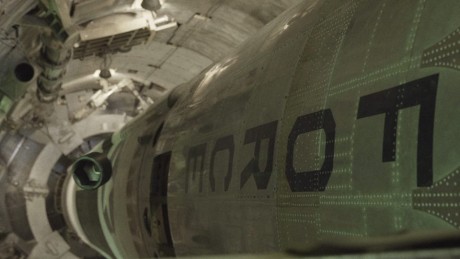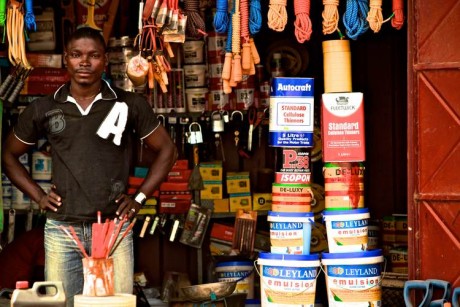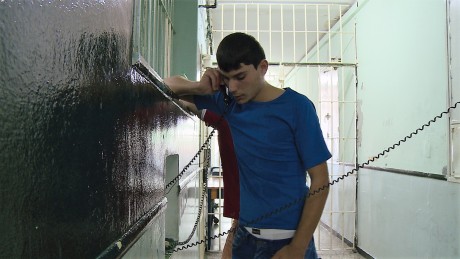Den barske herre hos fotografen hedder Joost de Wolf, han var en periode den militære chef for FN missionen MINUSMA. Han er den suveræne hovedperson i filmen ”The Mission”, et resolut værk, som faktisk er hans 90 minutters kyndige, skarpe, dybt personlige og – og vil publikum erfare – uforglemmelige analyse i en effektiv films form af FN styrkernes organisation, ledelse og indsats i den alvorlige konflikt i Mali.
Programredaktør i Cinemateket i København, Rasmus Brendstrup skriver om det meget omfattende arrangement, DOCS & TALKS, som Joost de Wolf således som den absolutte hovedperson i sin film og på den måde- deltager i som ekspert blandt en række eksperter, nogle i filmene som vises og andre i paneldiskussionerne bagefter. De Wolf deltager fra biograflærredet med sin mere end blot tankevækkende analyse:
”I perioden 21.-26. februar går DOCS & TALKS dybt i kødet på nogle af de centrale emner i verden: Atomvåben og sikkerhed, Afghanistans fremtid, internationale forsoningsprojekter, fattigdom og hjælpearbejde, migration mm. Midlet er en kombination af film og forskning.
”Hver dag fra tirsdag til søndag byder vi på foredrag eller debatter om konflikter eller udviklingstendenser i verden. Forskningen står centralt. Det særlige er, at festivalen i samme åndedrag zoomer ind på mennesker og detaljer – nemlig gennem dokumentarfilm,” siger Sara Thelle, der er en af festivalens programlæggere.
Som arrangører står Cinemateket og Dansk Institut for Internationale Studier (DIIS), der i 2016 blev rangeret som verdens syvendebedste tænketank uden for USA.
DIIS-forskere vil sammen med instruktører og inviterede eksperter – fra migranter til militærfolk – diskutere filmene og deres problemstillinger.
”Målet med Docs & Talks er at sætte forskning ind i en konkret kontekst på en anden måde end i den daglige nyhedsstrøm og dermed formidle viden på en dyb og levende måde til et bredt publikum. Publikum er velkomne – også med de kritiske spørgsmål,” siger Sara Thelle.
KRIGEN SET FRA TERAPIRUMMET
Som eksempel på et spørgsmål, festivalen vil prøve at afdække, nævner hun:
”Hvordan ser fortællingen om en krig ud, når den krænges ud foran en terapeut? Alle kender krigens slagmarker fra film og tv, men den ekstraordinære dokumentarfilm ’Of Men and War’ tillader os at komme med helt ind i det terapirum, hvor amerikanske krigsveteraner fra krigene i Irak og Afghanistan bliver behandlet for posttraumatisk stress syndrom (PTSD).”
Filmen vandt hovedprisen på IDFA, verdens største dokumentarfestival, og får her sin danske biografpremiere. Den viser bl.a., hvordan krig ’smitter’ familierne derhjemme.
Under Docs & Talks danner filmen afsæt for en debat om, hvordan militæret i dag håndterer PTSD og forsøger at modvirke konsekvenserne af krigens traumer. I panelet sidder DIIS-forskerne Robin May Schott og Johannes Lang, der studerer krigens psykologi, militærpsykolog Halfdan Fryd Koot samt en tidligere udsendt soldat.
GRÅZONER FOR FLYGTNINGE TIL DEBAT
Hvor går grænsen mellem flugt og menneskesmugling? På festivalens åbningsdag, tirsdag den 21. februar, sætter en anden danmarkspremiere ansigter på konsekvenserne af europæisk asylpolitik – nemlig den prisbelønnede dokumentar ’The Longest Run’.
”Vi har været så heldige at få instruktøren Marianna Economou til at komme og tale om filmen og de problematikker den tager op. Sammen med Ninna Nyberg Sørensen fra DIIS og psykolog Mohzdeh Ghasemiyani diskuterer hun hvilke gråzoner, der er forbundet med lovgivning om menneskesmugling, og om forholdene for uledsagede mindreårige flygtninge. Det er en vigtig debat,” siger Sara Thelle.
Og sådan fortsætter festivalen ellers at prøve at besvare vigtige, men komplekse spørgsmål:
Hvem er de afghanske soldater, der kæmper mod Taleban i Helmand-provinsen, efter NATO og de danske tropper er taget hjem? Hvilken rolle spiller filmmediet i det krigshærgede Damaskus? Kan internationalt nødhjælpsarbejde gøre folk fattigere? Hvornår er det klogt at sige undskyld for krigsforbrydelser? Hvordan beskriver syrienskrigere selv deres mission?
BÅNDET MELLEM FILM OG FORSKNING TIL DEBAT
Også selve festivalens DNA er genstand for debat: Båndet mellem film og forskning. Som en del af filmfestivalen samles forskere og repræsentanter fra filmbranchen fredag den 24. februar kl. 11-14 til et symposium med temaet: Hvordan bliver forskning til film?
”Stadig flere film er baseret på forskning eller er lavet i samarbejde med forskere – men springet fra tung tidsskriftartikel til forskningsbaseret film kan være svært, og ofte kræver det hjælp fra erfarne filmfolk. Vi vil gerne prøve at hjælpe processen på vej,” siger Mira Bach Hansen, en anden af festivalens programlæggere og kvinden bag symposiet.
Stills fra filmene ‘Dugma: The Button’ om syrienskrigere og ‘Poverty Inc.’ om fattigdomsbekæmpelse
PROGRAM:
Krigens psykologi: ‘Of Men and War’ + debat og efterfølgende reception Tirsdag den 21. februar kl. 12:30 / På flugt: ‘The Longest Run’ + debat og instruktørbesøg Tirsdag den 21. februar kl. 16:45 / FN-indsatsen i Mali: ‘The Mission’ + debat Onsdag den 22. februar kl. 13:00 / ‘Havet brænder’ + debat i Asta Bar Onsdag den 22. februar kl. 16:30 / ‘Dugma: The Button’ + debat Onsdag den 22. februar kl. 19:00 / ‘The Apology’ + debat Torsdag den 23. februar kl. 16:45 / ‘Tell Spring Not to Come This Year’ + debat Lørdag den 25. februar kl. 17:45 (med afghansk reception fra kl. 17.00) / Syrien: Kortfilmsprogram + debat Fredag den 24. februar kl. 16:30 ‘Poverty Inc’. + debat Torsdag den 23. februar kl. 20:30 / Branchesymposium: Hvordan bliver forskning til film? Fredag den 24. februar kl. 11:00 / Atomvåben: ‘Command and Control’ + debat Lørdag den 25. februar kl. 21:00 / Egypten efter foråret: ‘I Am the People’ + debat Søndag den 26. februar kl. 14:00
PRAKTISK INFORMATION Docs & Talks – film- og forskningsdage
Sted: Cinemateket, Gothersgade 55, Kbh K Tid: 21. februar 2017 – 26. februar 2017 Billetter (75 kr., dog 50 kr. for Cinematekets medlemmer og forhøjet billetpris ved brancheseminaret): Bestilles på tlf. 33 74 34 12 eller online her: www.dfi.dk/Filmhuset/Cinemateket/Billetter-og-program
For yderligere information kontakt:
Kommunikationsmedarbejder i DIIS Troels Jensen: 91 32 55 81 / trje@diis.dk.
Mira Bach, Forum for Film og Formidling, tlf. 3112 1003 / mirabach@gmail.com.
Programredaktør i Cinemateket Rasmus Brendstrup: +45 28 89 57 89 / rasmusb@dfi.dk.”







